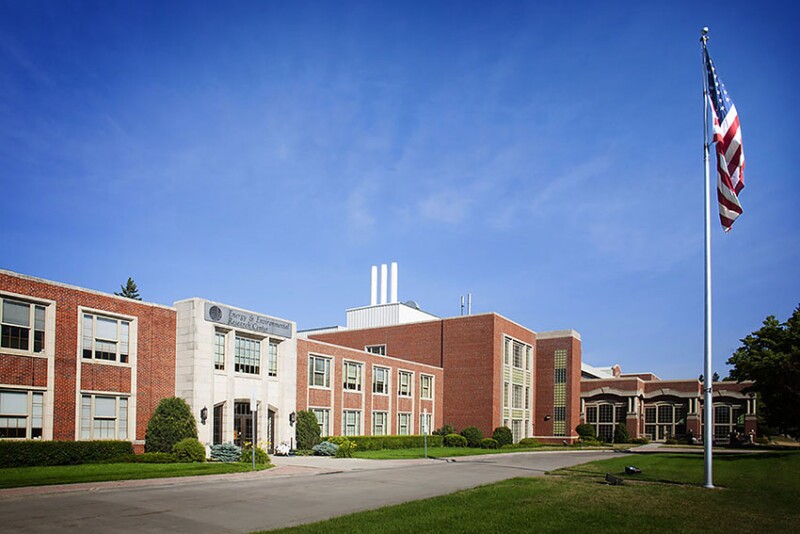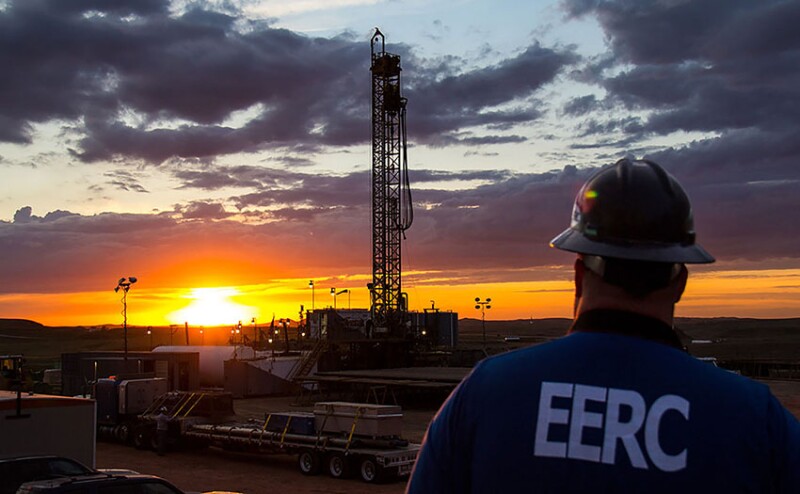In Grand Forks, North Dakota, engineers, geologists, and other specialists at the Energy & Environmental Research Center (EERC) are among those helping the state maintain its position as a leading US energy producer.
North Dakota currently produces about 1.1 million B/D, about 97% of which comes from the Bakken Shale, ranking the state third nationally behind Texas and New Mexico.
Much of the EERC’s research is focused on sustaining that output by extending the Bakken’s productive life. To do that the center’s researchers are developing new recovery methods while improving how produced gas, water, and emissions are managed across the maturing play.

The EERC, part of the University of North Dakota, is led by CEO Charles Gorecki, a petroleum engineer who joined the organization in 2007. Before assuming his current role, he directed the EERC’s subsurface research and development programs, leading the center’s work on conventional and unconventional reservoirs and enhanced oil recovery (EOR) projects.
In this conversation with JPT, Gorecki discusses how the EERC is working to recover more oil from existing wells, reduce methane emissions with new technology, and test advanced carbon capture systems. He also reflects on how North Dakota’s regulatory framework and practical approach have helped turn the state into a hub for collaboration, including with international partners in Japan and South Korea.
Editor’s note: This interview has been edited for length and clarity.
JPT: Thanks for talking to us. Can you give us a picture of the work that the EERC is doing and how it supports North Dakota’s role as a leading oil producer in the US?
Gorecki: The 30,000-ft view is that we’re a non‑teaching branch of the University of North Dakota with a vision to lead the world in developing solutions to energy and environmental challenges. This gigantic goal, and how that relates to something like the Bakken, involves us listening to our industry partners to find out what challenges that they’re having. We work with them to figure it out and solve those things, whether it’s about trying to produce a lower cost barrel of oil, reduce emissions, or maximize the resource that we’ve already found with existing wells.

We have engineers and scientists of all different types, but we’re problem solvers at heart, and we work with industry to solve those big challenges. That’s what we do.
Some of the biggest priorities we have center around the fact that we have found a lot of unconventional oil in North Dakota, but we’re only getting a tiny fraction of it out of the ground. A 10% recovery factor is, in my mind, very much on the high side. What we recover is probably in single-digit percentages, and with current technology we will have to leave most of it behind.
So, the EERC is trying to develop the new technologies that will help us get that next barrel out of the ground. EOR is among the big items we are focused on, but so are refracturing and artificial lift technology. We’re also looking at how to better manage the associated gas and produced water that comes up with the oil. How can we handle that more effectively, so it doesn’t limit production? We’re also studying infill drilling, parent-child well relationships, and new ways to recover those next barrels along with our partners.
JPT: The EERC reports annual research funding of about $60 to $90 million. How is that funding typically allocated?
Gorecki: That research funding comes through our partnerships, which include both industry and government collaborations. Typically, a call goes out to address a specific challenge, and we’ll develop and submit a proposal in response. We select those opportunities based on how well they align with our priorities and areas of expertise.
Our goal is to provide abundant, reliable, clean, and affordable energy. If we have the right mix of partners and believe a technology has a clear pathway to commercial viability, then it’s something we’ll high-grade. If it doesn’t align with those goals, it’s probably not a project we’ll pursue.
We have about 250 employees, so there’s only so much we can take on each year. We’re entirely soft money-funded, which means if we don’t have strong ideas and partners to work with, we don’t have projects, and ultimately, we don’t have jobs. That’s why we’re always out there listening, collaborating, and staying close to our partners to understand what challenges they’re facing. We do our best work when we operate as an extension of their companies.
JPT: Great. Let’s zero in on one of your big projects called the Bakken Production Optimization Program (BPOP). What would you say have been its biggest goals and achievements so far? And are there any specific examples you can share that highlight the program’s impact?
Gorecki: BPOP has been ongoing since 2013, which shows that for more than a decade we knew there were all kinds of challenges despite all the production.
One of the earliest things that BPOP worked on with operators and state regulators involved the setback distances required to be between drilling spacing units (DSUs). The big question was, what is the optimal distance?
Along with industry partners and the state, we identified that we could indeed drill wells much closer to the edges of the DSUs, which has resulted in accessing oil that wouldn’t have been as easily accessed. That resulted in additional tax revenue to the tune of over $1 billion for North Dakota and billions more in revenue for the oil producers and the mineral owners.
Our work has brought us together with the largest oil and gas producers in North Dakota, including Chord, Devon Energy, ConocoPhillips, Hess, and now Chevron, ExxonMobil, and Petro‑Hunt. We also collaborate with service companies on technologies that help increase oil recovery and on new software that improves our understanding of subsurface physics.
Refracturing is another big focus area for us. We’ve analyzed what’s been done across the basin from multiple operators to understand key factors such as sand and fluid volumes and how successful those treatments were in creating new hydraulic fractures and added production. We also partnered up with operators to identify the best candidates for refracturing by looking at analog wells with high post-refrac performance and assessing economics to help them make investment decisions.
That’s another example of a project that contributed to a more than $1 billion economic impact for the state and operators through additional production.
JPT: As you look beyond lease lines and refracturing, what other projects hold potential for such impact?
Gorecki: We continue to work on many projects, but one we keep pushing on hard is EOR. We’ve been involved in four different unconventional pilots using injections of CO2 and produced gas. Each time, we faced different questions and different challenges that we’re trying to solve for.
In some early work, we saw challenges with being able to handle conformance of injected gas, but we eventually were able to handle that and gain an uplift in production. Now, we are seeing the next phase of these projects getting closer to commercial viability as they scale to multiple wells on multiple DSUs.
I’ll touch on one more thing here: methane-emissions mitigation and flaring reduction.
We’ve been working to identify where the flaring is happening, and we knew it was temporal in nature. Volumes can change radically, and sometimes when we get to a unit for gas recovery, the flaring is much lower than expected. We did a lot of analysis of the challenge with our operator partners, and since then, a lot of the biggest flares have been replaced with vapor recovery and other technologies.
The remaining challenge involved the small-scale flaring and methane emissions, which cumulatively account for a huge amount of gas. So, we developed a flare-reduction technology called Polar Bear.
The key to it is a reciprocating compressor that doesn’t use oil, making it very inexpensive. We worked with a manufacturer to build one that could handle wet gas or low-pressure gas to get it back into the production system instead of being vented or flared. It’s now commercial and being deployed through our manufacturing partner, Steffes, here in North Dakota, and the plan is to get hundreds installed across the Bakken.
JPT: Let’s talk about carbon capture and storage (CCS). The EERC recently said that it has helped North Dakota become a proving ground for almost every kind of CCS technology out there. What’s made that possible?
Gorecki: I think it comes back to who we are at the EERC and where we came from. We are originally a US Bureau of Mines facility. And when we were formed in the 1950s, our mission was all about turning low-rank coal into products that could be gasified and their emissions controlled.
Building on that legacy, we have since built a CO2-capture unit that’s been used to test nearly every major CCS technology in existence. Leading CCS players, including Mitsubishi Heavy Industries, Hitachi, and Shell, have all tested their systems here through our industry partnerships.
We began this work more than 20 years ago, well before the Bakken boom produced a billion bbl of oil, and recognized then that formations such as the Broom Creek and Deadwood sandstones have the capacity to store billions of tons of CO2.
We’ve always worked closely with the state and with regulators. It’s about bringing scientists and policymakers together to prove out new technology. Early on, North Dakota moved to get out in front of CCS with us as it decided to establish comprehensive rules on key issues such as pore-space ownership, long-term liability, and the permitting framework for CCS projects. Those regulations were in place before the US Environmental Protection Agency finalized its own, making North Dakota the first state to develop a full regulatory framework for carbon storage.
JPT: EERC has also formed international partnerships that touch other parts of the energy sector. How do these relationships operate, and where’s the mutual benefit?
Gorecki: Our collaborations include some technology-focused projects with Japan and South Korea. Both countries have very limited oil and gas resources and little to no capacity for carbon storage, yet they very much want to be a part of the energy value chain and decarbonize their own industries, and they’ve partnered with the US to develop new technology along those lines.
We’ve been working with these countries alongside industry partners and the state of North Dakota on solutions for compressors, gas turbines, and CO2 capture solvents. We’ve also teamed up with Japanese companies to develop fiber- optic monitoring technologies and have deployed those in our CCS storage projects here in the US.
We’re very good at building public–private partnerships, and when public funding is involved, a core part of our mission is technology transfer. We want to share technology and knowledge in order to advance the industry here in the US and with our trade allies and partners around the world.


